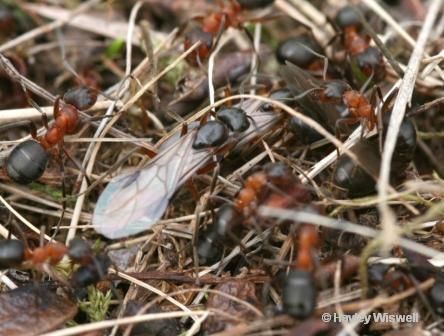Lifecycle and Social Structure
Lifecycle
This can refer both to individual ants and also to the colony. Ants begin their lives as eggs laid by the queen. The queen lays two kinds of eggs - fertilised and unfertilised - and she alone has control over this process. Fertilised eggs develop into females and unfertilised eggs into males. The workers remove the eggs from the queen to the nursery chamber. They hatch into white legless grubs who are fed by the adult workers. They moult several times, growing bigger with each successive moult. Those destined to be queens are fed more and so grow larger. Once fully grown, the grubs spin a cocoon and inside metamorphosize (change) into an adult ant. Males and queens are not only bigger than workers, they also have wings. Queens can live 15-20 years but males only a few weeks and workers around two months. The exception to this are workers which overwinter.
Social Structure
Wood ants live in colonies with can contain one or more interlinked nests, and one or more queens. Some colonies (such as the Japanese wood ant Formica yessensis) can contain hundreds of queens. Males and queens are usually only produced by healthy nests of a certain age (often at least five years old). Newly emerging queens mate either on the nest surface, on the ground or in the air (nuptial flights).

The nests of Formica lemani and Formica fusca are quite often invaded by wood ant queens which either enter by stealth or are carried into the nest by host workers which surprisingly display little hostility. The invading queen kills the host queen and takes over the brood chamber, laying her own eggs which the host ants raise. Eventually as the host worker ants die out, the nest becomes entirely composed of wood ants.
Formica sanguinea, commony known as the blood-red slave maker, takes social parasitism to a different level, not only through queens establishing new colonies in the nests of other ant species, but related species are also raided in order to kidnap brood which are reared to form slaves and even food. (See the species profile on Formica sanguinea).
A wood ant colony will live as long as there is a queen present. So if there are multiple queens present, or a daughter takes over from her mother, the colony can persist for decades.
In addition to this, colonies also have a seasonal cycle. Only the queen and a number of workers live through the winter living deep inside the nest and surviving on their own body fat. Once temperatures start to rise in the spring, the workers emerge and begin foraging. The first brood is usually just workers but after that males and queens may also be produced, usually between May and July. In the autumn, the queen stops laying eggs and activity dies down again until the spring.

